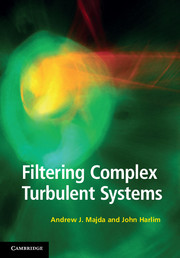Book contents
- Frontmatter
- Contents
- Preface
- 1 Introduction and overview: Mathematical strategies for filtering turbulent systems
- Part I Fundamentals
- Part II Mathematical guidelines for filtering turbulent signals
- Part III Filtering turbulent nonlinear dynamical systems
- 9 Strategies for filtering nonlinear systems
- 10 Filtering prototype nonlinear slow–fast systems
- 11 Filtering turbulent nonlinear dynamical systems by finite ensemble methods
- 12 Filtering turbulent nonlinear dynamical systems by linear stochastic models
- 13 Stochastic parametrized extended Kalman filter for filtering turbulent signals with model error
- 14 Filtering turbulent tracers from partial observations: An exactly solvable test model
- 15 The search for efficient skillful particle filters for high-dimensional turbulent dynamical systems
- References
- Index
10 - Filtering prototype nonlinear slow–fast systems
from Part III - Filtering turbulent nonlinear dynamical systems
Published online by Cambridge University Press: 05 March 2012
- Frontmatter
- Contents
- Preface
- 1 Introduction and overview: Mathematical strategies for filtering turbulent systems
- Part I Fundamentals
- Part II Mathematical guidelines for filtering turbulent signals
- Part III Filtering turbulent nonlinear dynamical systems
- 9 Strategies for filtering nonlinear systems
- 10 Filtering prototype nonlinear slow–fast systems
- 11 Filtering turbulent nonlinear dynamical systems by finite ensemble methods
- 12 Filtering turbulent nonlinear dynamical systems by linear stochastic models
- 13 Stochastic parametrized extended Kalman filter for filtering turbulent signals with model error
- 14 Filtering turbulent tracers from partial observations: An exactly solvable test model
- 15 The search for efficient skillful particle filters for high-dimensional turbulent dynamical systems
- References
- Index
Summary
Many contemporary problems in science and engineering involve large-dimensional turbulent nonlinear systems with multiple time-scales, i.e. slow-fast systems. Here we introduce a prototype nonlinear slow-fast system with exactly solvable first- and second-order statistics which despite its simplicity, mimics crucial features of realistic vastly more complex physical systems. The exactly solvable features facilitate new nonlinear filtering algorithms (see Chapter 13 for another use in stochastic parametrizations) and allow for unambiguous comparison of the true signal with an approximate filtering strategy to understand model error. First we present an overview of the models, the main issues in filtering slow–fast systems, and filter performance. In the second part of this chapter we give more pedagogical details.
The nonlinear test model for filtering slow–fast systems with strong fast forcing: An overview
The dynamic models for the coupled atmosphere–ocean system are prototype examples of slow–fast systems where the slow modes are advective vortical modes and the fast modes are gravity waves (Salmon, 1998; Embid and Majda, 1998; Majda, 2003). Depending on the spatio-temporal scale, one might need only a statistical estimate through filtering of the slow modes, as in synoptic scales in the atmosphere (Daley, 1991) or both slow and fast modes such as for squall lines on mesoscales due to the impact of moist convection (Khouider and Majda, 2006).
- Type
- Chapter
- Information
- Filtering Complex Turbulent Systems , pp. 153 - 191Publisher: Cambridge University PressPrint publication year: 2012



